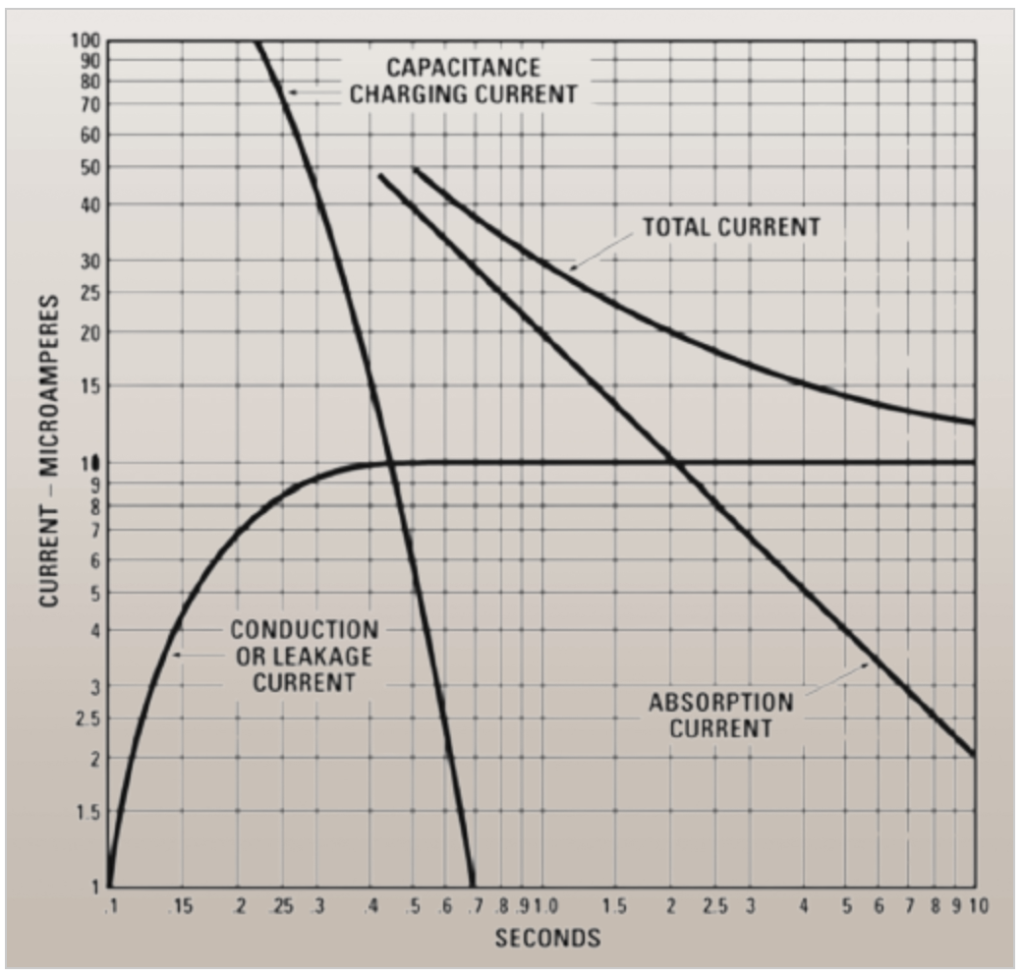The measured resistance of insulation is influenced by several factors, which are essential to understand when performing insulation resistance tests. One of the fundamental principles to keep in mind is Ohm’s law (R = E/I), which relates resistance (R) to voltage (E) and current (I). Here, we’ll explore how various factors affect the current flowing through insulation and, consequently, insulation resistance readings.

1. Temperature and Humidity:
- Temperature: The temperature of the insulation can impact its resistance. Generally, as temperature decreases or moisture content increases, resistance decreases.
- Humidity: High humidity levels can create a lower resistance path for current in the insulation.
2. Time-Dependent Current Components:
When measuring insulation resistance, it’s important to recognize that the current through insulation comprises three distinct components, each with its characteristics:
- Capacitance Charging Current: This is an initial high current that gradually decreases as the insulation charges to full voltage. It’s analogous to water flow in a garden hose when you first turn on the spigot.
- Absorption Current: Similar to capacitance charging current, it starts high and then decreases. The rate of decrease depends on the insulation material.
- Conduction or Leakage Current: This is a small, essentially steady current that flows both through and over the insulation.
3. Time-Resistance Relationship:
- Total Current: The total current flowing through the insulation is the sum of these three components. This current can be measured directly using a microammeter or, in terms of megohms at a particular voltage, using a Megger instrument (ohmmeter).
- Time Dependency: The total current depends on the duration for which voltage is applied. In theory, Ohm’s Law (R = E/I) holds only at an infinite time (which is impractical). In practice, you obtain an apparent resistance value that serves diagnostic purposes.
4. Capacitance Charging Current:
- This component disappears relatively quickly as the equipment under test becomes charged. Larger equipment with more capacitance may take longer to charge.
- Safety Measure: After the test, it’s crucial to discharge this stored energy by short-circuiting and grounding the insulation. Always perform this safety step.
5. Absorption Current:
- Absorption current decreases at a relatively slow rate and depends on the nature of the insulation material.
- Discharge Time: Releasing this stored energy at the end of a test takes about four times as long as the duration for which voltage was applied.
6. Conduction or Leakage Current:
- Good insulation should have a steady leakage current that remains constant for the applied voltage.
- Increasing Leakage Current: Any rise in leakage current over time signals potential trouble and should be investigated.
Understanding these factors is crucial for accurate insulation resistance testing. It sets the foundation for three common test methods: short-time or spot reading, time-resistance, and step or multi-voltage tests, which will be explained further in the following sections.
Related Articles:
What is Good insulation?
What Makes Insulation Go Bad?
How Insulation Resistance is Measured.
How to Interpret Resistance Readings.
Types of Insulation Resistance Tests.
Test Voltage vs. Equipment Rating.
AC Testing vs. DC.
Use of DC Dielectric Test Set.
Tests During Drying out of Equipment.
Effect of Temperature on insulation Resistance.
Effects of humidity.
Preparation of Apparatus to test.
Safety Precautions.
Connections for testing insulation resistance of electrical equipment.
Additional Notes About using A Megger Insulation Tester.
Interpretation-Minimum Values.
Minimum Values for Insulation Resistance.
Tests Using Multi-Voltage Megger Insulation Testers.
Step-Voltage Method.
Use of a Guard Terminal.
Outdoor Oil Circuit Breaker.